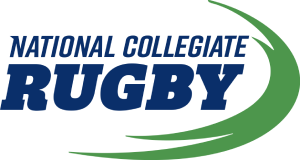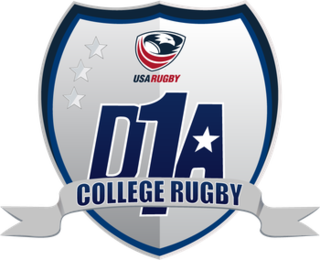
The Penn State Nittany Lions are the athletic teams of Pennsylvania State University, except for the women's basketball team, known as the Lady Lions. The school colors are navy blue and white. The school mascot is the Nittany Lion. The intercollegiate athletics logo was commissioned in 1983.

The Lady Ruggers are Penn State University's (PSU) Women's Rugby Football Club sports team, established in 1991. They are a Division 1 Elite rugby team who play under USA Rugby, American rugby's governing body. Although they are an official PSU team the women's rugby program at PSU is not funded as a varsity sport and therefore cannot be officially called the "Nittany Lions". The team is part of the Penn State athletic department's "team sports" program and plays other school's varsity teams.

The Navy Midshipmen are the athletic teams that represent the United States Naval Academy. The academy sponsors 36 varsity sports teams and 12 club sport teams. Both men's and women's teams are called Navy Midshipmen or "Mids". They participate in the NCAA's Division I, as a non-football member of the Patriot League, a football-only member of the American Athletic Conference in the Football Bowl Subdivision (FBS), and a member of the Collegiate Sprint Football League (men), Eastern Association of Rowing Colleges (men), Eastern Association of Women's Rowing Colleges, Eastern Intercollegiate Gymnastics League (men), Mid-Atlantic Squash Conference (men) and Eastern Intercollegiate Wrestling Association. Navy is also one of approximately 300 members of the Eastern College Athletic Conference (ECAC).

College lacrosse is played by student-athletes at colleges and universities in the United States and Canada. In both countries, men's field lacrosse and women's lacrosse are played at both the varsity and club levels. College lacrosse in Canada is sponsored by the Canadian University Field Lacrosse Association (CUFLA) and Maritime University Field Lacrosse League (MUFLL), while in the United States, varsity men's and women's lacrosse is governed by the National Collegiate Athletic Association (NCAA), National Junior College Athletic Association (NJCAA) and National Association of Intercollegiate Athletics (NAIA). There are also university lacrosse programs in the United Kingdom sponsored by British Universities and Colleges Sport (BUCS) and programs in Japan.

The Kutztown Golden Bears are the sports teams that represent Kutztown University of Pennsylvania, located in Kutztown, Pennsylvania. Kutztown University is a member of NCAA Division II and competes in the Pennsylvania State Athletic Conference (PSAC). The university sponsors eight men's and fourteen women's intercollegiate sports. In 2022, Kutztown University added women's acrobatics & tumbling as its 22nd varsity sport.

The Central Washington Wildcats are the 15 varsity athletic teams that represent Central Washington University, located in Ellensburg, Washington, in NCAA Division II intercollegiate sports. The Wildcats compete as members of the Great Northwest Athletic Conference.

The Lindenwood Lions and Lady Lions are the intercollegiate athletic teams that represent Lindenwood University, located in St. Charles, Missouri, in intercollegiate sports as a member of the NCAA Division I ranks, primarily competing in the Ohio Valley Conference for most of its sports since the 2022–23 academic year.

National Collegiate Rugby (NCR) formerly the "National Small College Rugby Organization" is a rugby union governing body in the United States. Headquartered in Wilmington, Delaware, NCR was created in 2007 by Chip Auscavitch and Steve Cohen to support and encourage the development and organization of small college rugby in the country.
The first tier of intercollegiate sports in the United States includes sports that are sanctioned by one of the collegiate sport governing bodies. The major sanctioning organization is the National Collegiate Athletic Association (NCAA). Before mid-1981, women's top-tier intercollegiate sports were solely governed by the Association for Intercollegiate Athletics for Women (AIAW). Smaller colleges are governed by the National Association of Intercollegiate Athletics (NAIA). Two-year colleges are governed by the National Junior College Athletic Association (NJCAA) in most of the country, except for the unaffiliated California Community College Athletic Association (CCCAA) and Northwest Athletic Conference (NWAC).

The Davenport Panthers are the athletic teams that represent Davenport University, located in Caledonia Township, Michigan, in intercollegiate sports as a member of the NCAA Division II level of the National Collegiate Athletic Association (NCAA), primarily competing in the Great Lakes Intercollegiate Athletic Conference (GLIAC) for most of its sports as a provisional member since the 2017–18 academic year. The Panthers previously competed in the Wolverine–Hoosier Athletic Conference (WHAC) of the National Association of Intercollegiate Athletics (NAIA) from 2005–06 to 2016–17.

The Western Oregon Wolves are the athletic teams that represent Western Oregon University, located in Monmouth, Oregon, in intercollegiate sports as a member of the Division II level of the National Collegiate Athletic Association (NCAA), primarily competing in the Great Northwest Athletic Conference (GNAC) since the 2001–02 academic year. The Wolves previously competed in the D-II Pacific West Conference (PacWest) from 1998–99 to 2000–01; and in the Cascade Collegiate Conference (CCC) of the National Association of Intercollegiate Athletics (NAIA) from 1993–94 to 1997–98.

Division 1-A Rugby is the highest level of college rugby within the United States and is administered by USA Rugby. Division 1-A rugby is modeled after NCAA athletic competitions, with the 46 D1-A rugby schools divided into eight conferences: East, Midwest, Rocky Mountain, California, Big Ten, Red River, PAC, and Independent.

The Collegiate Rugby Championship (CRC) is an annual college rugby sevens tournament. The CRC is the highest profile college rugby sevens competition in the United States, with the tournament broadcast live on NBC from 2010–2017, on ESPN News and ESPN3 from 2018–2019, The Rugby Network in 2021 and 2023, and on CBS Sports in 2022. The CRC capitalized on the surge in popularity of rugby following the 2009 announcement of the addition of rugby sevens to the Summer Olympics. Beginning in 2021, the tournament has been organized by National Collegiate Rugby under license for the name and logo.
The USA Rugby Sevens Collegiate National Championships is an annual competition among the top college rugby teams in the country to decide a national champion in rugby sevens. USA Rugby organized the championship to capitalize on the surge in popularity of rugby sevens following the 2009 announcement of the addition of rugby to the Summer Olympics. USA Rugby recognized that rugby sevens is growing in popularity, participation and interest. At the time of the foundation of the tournament, rugby was one of the fastest growing sports across college campuses. This tournament is a major contributor to the selection process for USA Rugby Olympic athletes.

The St. Edward's Hilltoppers are the athletic teams that represent St. Edward's University, located in Austin, Texas, in NCAA Division II intercollegiate sporting competitions. The Hilltoppers compete as members of the Lone Star Conference for all 13 varsity sports. St. Edward's was a member of the Heartland Conference from 1999 to 2019.
This is a list of results and records for the USA Rugby National Collegiate Men's Rugby Championships, which began in 1980. The 1984–1988 and 1990 editions were played in conjunction with the Annual Pebble Beach Rugby Classic. In 2010, several of the top college teams agreed to form the College Premier League, now known as Division 1-A Rugby to begin play in spring 2011. This list does not include records from the breakaway invitational Varsity Cup Championship held between 2013 and 2017, nor from the rival National Collegiate Rugby Organization's D1 championship that began in 2021.
Big Ten Universities is a Division 1-A college rugby conference founded in summer 2012 by ten of the twelve schools that then made up the Big Ten Conference. The Big Ten Universities was formed to improve rugby among the Big Ten schools by capitalizing on traditional Big Ten rivalries, increasing the number of fans, attracting talented high school rugby players, and playing other regional schools, which would create more competitive matchups with traditional rivals.
The Lindenwood Lions men's rugby team represents Lindenwood University in college rugby. Lindenwood plays in Division I-A in the Mid-South conference. The team is coached by Josh Macy. The Lindenwood men's rugby team won the 2012 USA Rugby Division II national championship in its inaugural season, and finished second in Division I-AA for the 2012-13 season. Following the 2012-13 season, Lindenwood moved up to Division I-A for the 2013-14 season. Lindenwood has also had success in Sevens. The Lions won the D1 7s National Championship in 2015 & the Red Bull University 7s Championship.

The Varsity Cup Championship was an American college rugby competition established in 2012 to serve as an invitational championship following the breakaway of several schools from Division 1-A Rugby.
The 2023 Division 1-A Rugby Championship is the eleventh season of the Division 1-A Rugby championship, the annual university rugby union competition run by USA Rugby for teams from the top twelve college teams in the United States. Navy won their first Championship with a 28–22 win over California, capping a perfect 18–0 season.


















